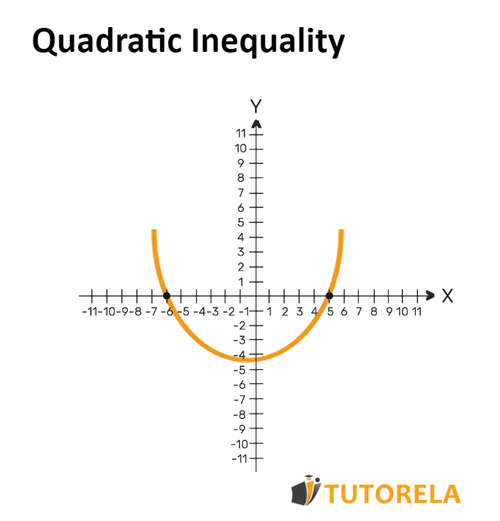The quadratic inequality shows us in which interval the function is positive and in which it is negative - according to the inequality symbol. To solve quadratic inequalities correctly, it is convenient to remember two things:
Quadratic Inequality
- Set of positivity and negativity of the function:
Set of positivity - represents the s in which the graph of the parabola is above the axis, with value positive.
Set of negativity - represents the s in which the graph of the parabola is below the axis, with value negative. - Dividing by a negative term - reverses the sign of the inequality.
Method to solve the quadratic inequality:
- We will carry out the transposition of members and isolate the quadratic equation until one side equals 0. Remember that when we divide by a negative term, the inequality is reversed.
- Let's draw a diagram of the parabola - placing points of intersection with the axis and identifying the maximum and minimum of the parabola.
- Let's calculate the corresponding interval according to the exercise and the diagram.
Quadratic equation Set of positivity
Quadratic equation Set of negativity
Test yourself on quadratic inequalities!
Solve the following equation:
\( x^2+4>0 \)
Let's look at an example of a quadratic inequality
Solution:
We will progress step by step:
1) Let's transpose terms and isolate the quadratic equation until one side equals . Remember that when we divide by a negative term, the inequality is reversed.
In the first step, we will leave on one side of the equation.
Note that, in this exercise, we must first solve what appears between parentheses.
We will open the parentheses and obtain:
Now let's transpose terms and we will obtain:
Magnificent. We have left on one side. Let's continue to the second step.
2) Let's draw a diagram of the parabola - placing intersection points with the axis and identifying the maximum and minimum of the parabola.
Let's find the intersection points of the function with the axis:
According to the quadratic formula we will obtain:
We will see that the extremity of the function is the minimum (smile) since the coefficient of is positive.
Let's draw a diagram:

3) Let's calculate the corresponding interval according to the exercise and the diagram.
In the exercise, we arrived at the following equation:
That is, we are looking for the intervals in which the function is greater than . Its set of positivity.
We will ask ourselves: In which intervals is the function positive? At which s is the graph of the function above the axis?
The answer is when
And these are the solutions for the quadratic inequality.
If you are interested in this article, you might also be interested in the following articles:
Family of parabolas y=x²+c: Vertical shift
Family of parabolas y=(x-p)²+k (combination of horizontal and vertical shift)
Vertex form of the quadratic function
Factored form of the quadratic function
Completing the square in a quadratic equation
Standard form of the quadratic function
System of quadratic equations - Algebraic and graphical solution
Solution of a system of equations when one is linear and the other quadratic
In the Tutorela blog, you will find a variety of articles on mathematics.
Examples and exercises with solutions of quadratic inequality
Exercise #1
Solve the following equation:
Video Solution
Step-by-Step Solution
To solve this problem, let's examine the inequality .
The expression consists of two terms: and . Notice that:
- The term is always non-negative, which means for any real number .
- The constant term is positive.
Combining these observations, we see that:
- Since is non-negative, .
- Therefore, is always greater than zero, as adding 4 to a non-negative number will always yield a positive result.
Thus, there are no values of for which the expression is zero or negative. Instead, the expression is always positive for all real numbers .
Therefore, the solution to the inequality is all values of .
Answer
All values of
Exercise #2
Solve the following equation:
Video Solution
Step-by-Step Solution
Let's explore this problem step-by-step:
The inequality given is .
1. To understand this inequality, we start by considering the expression . We know that for any real number , . This means is always non-negative.
2. Since for every real number, adding 9 to will necessarily make the expression greater than zero, because a non-negative number plus a positive number gives a positive result: .
3. Therefore, the inequality holds true for all real numbers . There is no value of that makes the left side equal to or less than zero.
4. Thus, the solution to the inequality is that it holds for all values of .
Consequently, the correct choice from the options provided is:
- All values of
Therefore, the solution is that the inequality is true for all values of .
Answer
All values of
Exercise #3
Solve the following equation:
Video Solution
Step-by-Step Solution
To solve the inequality , we begin by considering the corresponding equation .
First, factor the quadratic equation:
- Rearrange the terms: becomes .
- This gives us the roots and .
These roots divide the number line into three intervals: , , and .
We need to test these intervals to determine where the inequality holds:
- For , choose a test point like : the expression , which is not greater than zero.
- For , choose a test point like : the expression , which is greater than zero.
- For , choose a test point like : the expression , which is not greater than zero.
Thus, the inequality is satisfied for the interval .
Therefore, the solution to the inequality is , which corresponds to choice 2 in the given options.
Answer
Exercise #4
Solve the following equation:
Video Solution
Step-by-Step Solution
To solve this quadratic inequality, , we will follow these steps:
- Step 1: Identify the quadratic expression .
- Step 2: Attempt transformation and determine when the expression , can be greater than zero.
Let's analyze the equation:
Rewrite the inequality:
Add 9 to both sides:
Multiply the entire inequality by and remember to reverse the inequality sign:
Observe the inequality :
Note that , being a square of any real number, is always greater than or equal to zero.
As cannot be less than negative nine for any real number , the inequality has no solution in the realm of real numbers.
Therefore, the correct answer is:
There is no solution.
Answer
There is no solution.
Exercise #5
Solve the following equation:
Video Solution
Step-by-Step Solution
Let's proceed to solve the inequality .
- Start by factoring the quadratic: .
- Identify the factors of 12 that sum to 8: and . This results in: .
The factorization gives us the critical points and . These points divide the number line into three intervals: , , and .
Now, we evaluate the sign of the product in each interval:
- For : Both and are negative, so their product is positive.
- For : is positive, is negative, so their product is negative.
- For : Both and are positive, so their product is positive.
The inequality holds for and .
Thus, the solution to the inequality is or .
Therefore, the correct answer is .
Answer
Solve the following equation:
\( x^2+9>0 \)
Solve the following equation:
\( -x^2-9>0 \)
Solve the following equation:
\( -x^2+2x>0 \)
More Questions
- Inequalities
- Inequalities with Absolute Value
- Absolute Value Inequalities
- Quadratice Equations and Systems of Quadraric Equations
- Quadratic Equations System - Algebraic and Graphical Solution
- Solution of a system of equations - one of them is linear and the other quadratic
- Intersection between two parabolas
- Word Problems
- The quadratic function
- Parabola
- Symmetry in a parabola
- Plotting the Quadratic Function Using Parameters a, b and c
- Finding the Zeros of a Parabola
- Methods for Solving a Quadratic Function
- Squared Trinomial
- The quadratic equation









